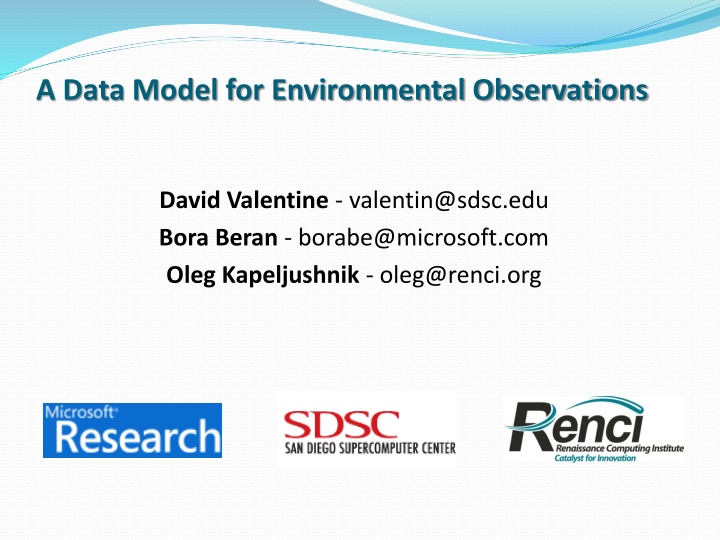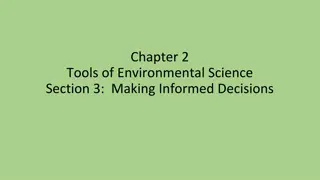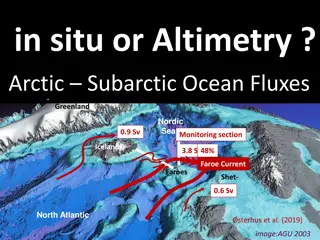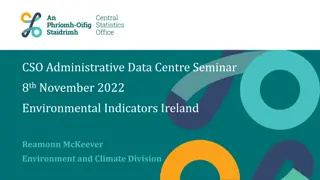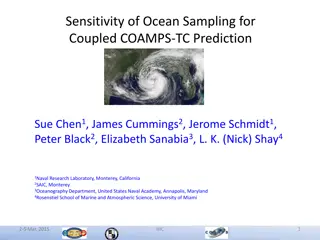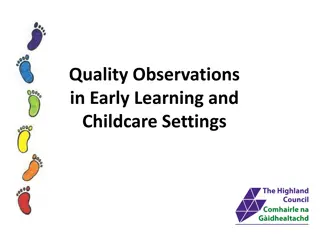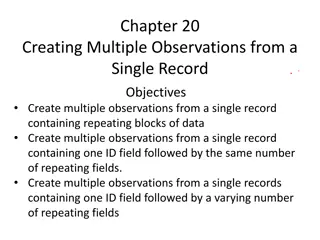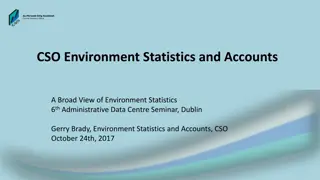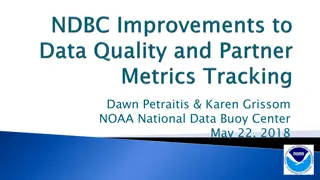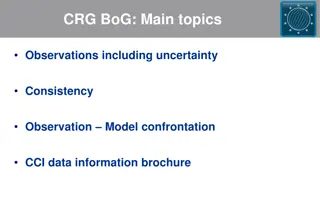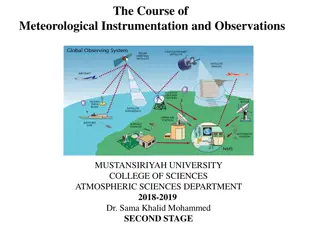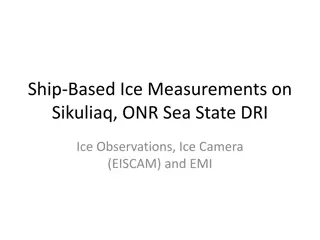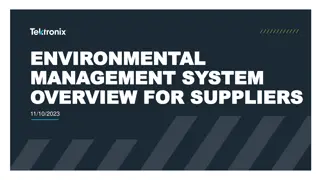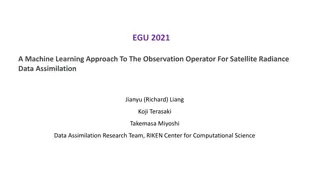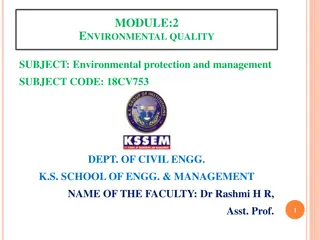Data Model for Environmental Observations
Challenges in storing environmental data, maintaining integrity and interoperability. Overview of Observations Data Model, Database Model Entity Data Model, and usage scenarios. Introduction to FLUXNET, CUAHSI, RENCI initiatives for environmental data collection and analysis.
Download Presentation

Please find below an Image/Link to download the presentation.
The content on the website is provided AS IS for your information and personal use only. It may not be sold, licensed, or shared on other websites without obtaining consent from the author.If you encounter any issues during the download, it is possible that the publisher has removed the file from their server.
You are allowed to download the files provided on this website for personal or commercial use, subject to the condition that they are used lawfully. All files are the property of their respective owners.
The content on the website is provided AS IS for your information and personal use only. It may not be sold, licensed, or shared on other websites without obtaining consent from the author.
E N D
Presentation Transcript
A Data Model for Environmental Observations David Valentine - valentin@sdsc.edu Bora Beran - borabe@microsoft.com Oleg Kapeljushnik - oleg@renci.org SDSC - San Diego Super Computer Center Microsoft
Challenges of Environmental Data Storage Maintain data integrity, interoperability and completeness even for non-database professionals Easily organize and navigate disparate data sets Interact with data at higher level than SQL queries Discussion Outline Observations Data Model (ODM) Database Model Entity Data Model (EDM) Usage scenarios and examples
FLUXNET A network of networks To better understand the net ecosystem productivity and carbon sequestration of the terrestrial biosphere TCOS-Siberia University of Tuscia Oak Ridge National Lab - Earth Sciences CarboEuropeIP CarboAfrica NECC AsiaFlux 250+ towers, 950+ site years of data AmeriFlux OZ Flux Micrometeorology: e.g. CO2, H2O and energy fluxes KoFlux LBA http://www.fluxdata.org
CUAHSI An organization of hydrologists with 115 member institutions Involved in cyberinfrastructure efforts since 2004 11 test-bed sites funded through NSF s Environmental Observatory Program Developers of ODM v1.0 (and v1.1) http://his.cuahsi.org/odmdatabases.html WaterML (WaterOneFlow) Web Services http://his.cuahsi.org/wofws.html http://www.cuahsi.org
Renaissance Computing Institute (RENCI) Disaster Studies Initiative Brunswick County Flood Sensor (BCFS) network Real-time data for county officials and the NWS to assess flooding hot spots in the county https://www.sensordatabus.org/bcfs UNC Charlotte weather stations Real-time weather data collection in Brunswick County throughout hurricane season BCFS Project Motto: When you are up to your eyeballs in alligators, it is hard to remember that you are there to monitor the swamp --Ilia Baldine, Renci http://www.renci.org
Renaissance Computing Institute (RENCI) North Carolina Environmental Observation Network System (NC-EONS) Pamlico Sound Understanding marine ecosystems and possible effects of climate change 5.8 gigahertz high-speed wireless communications link at the ferry terminal, VHF 9600 baud packet switched network and a 902 megahertz wireless network Sept 30th, 71-foot steel trawler accidentally strikes the platform To be rebuilt in Spring 2009 https://www.nceons.org/
Renaissance Computing Institute (RENCI) Sensor Data Bus (SDB) Hosting platform for the aforementioned science projects, among others Repository/data warehouse for all of our sensor data Tools, technologies and services centered around interacting with disparate forms of sensor data and corresponding metadata All code and tooling developed on top of ODM (v2.0), the Entity Data Model, and the Microsoft platform will be released under FreeBSD style open source license https://www.sensordatabus.org
Data Model for Environmental Observations Spatial support Extensibility Ancillary data support Ease of use Provenance tracking Versions Namespace translation Entity Framework FLUXNET S T O R E D P R O C S Database Schema CUAHSI RENCI User Defined Types Others
Data Model for Environmental Observations NEW DATA TYPES STREAMLINED DESIGN Collections Translation Extensibility Data Core SPATIAL SUPPORT ftp://ftp.research.microsoft.com/pub/tr/TR-2008-92.pdf
Entity Framework Key Features Separates application from database schema Object oriented Interact with data as objects Entity types can inherit from other entity types Acts as DAO layer of an application Various technologies which work with EDM Entity-SQL LINQ to Entities ADO.NET Data Services And more
A Data Model for Environmental Observations SELECT NULL END) AS [Dam Type], MAX(CASE WHEN PropertyName = 'Dam, Purpose' THEN [PropertyValue] ELSE NULL END) AS [Dam Purpose] FROM SciScope.dbo.ODCore_Feature AS F INNER JOIN dbo.ODExtensibility_FeatureProperty AS P ON F.FeatureID = P.FeatureID INNER JOIN dbo.ODExtensibility_GenericProperty AS G ON G.PropertyID = P.PropertyID WHERE 'Dam') GROUP BY P.FeatureID P.FeatureID, MAX(CASE WHEN PropertyName = 'Dam Type' THEN [PropertyValue] ELSE (F.FeatureType = Entity SQL Query<Dam> DamsQuery = db.GetQuery<Dam>( "SELECT * FROM Dams"); LINQ to Entities IQueryable<Dam>DamsQuery = from d in Dams select d; Entity Data Model Why an Entity Data Model? Simplifies code development User to deals with conceptual model rather than database schema DB schema changes don t affect software built on top of the entity model
Features and Events 1. Watershed (feature) 2. Hurricane (event) 3. Dam (feature) 4. Drought (event) 5. Aquifer (feature) Hurricane Floyd (1999) Usage Scenarios 1. How does this hurricane compare with others? 2. What is the average precipitation and its departure from normal for the watershed above some reservoir?
Usage examples 1. .NET code 2. Web Services 3. ADO.NET Data Services
Summary ODM2 and associated tooling can have a significant impact in data interoperability and availability Common interfaces lead to a rich ecosystem of tooling - ODM Tools and WaterOneFlow Services are just the beginning The Entity Framework and .Net platform features such as LINQ to SQL will enable more rapid and intuitive software development
Resources www.renci.org www.sensordatabus.org ftp://ftp.research.microsoft.com/pub/tr/TR-2008-92.pdf 1. 2. 3.
